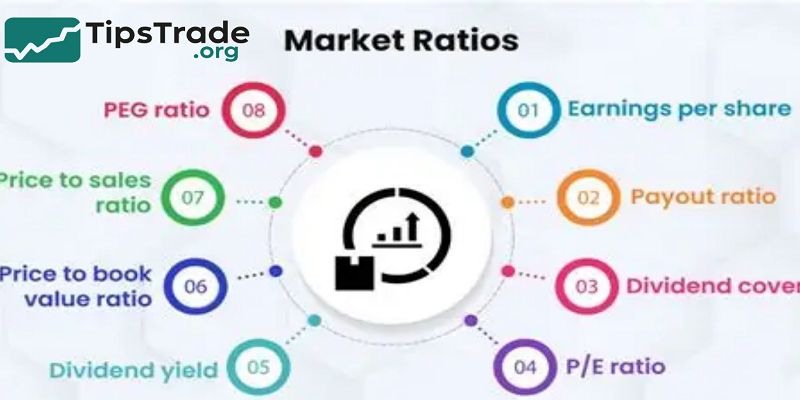Market ratios are a group of financial indicators that compare a company’s stock price to various fundamental metrics such as earnings, sales, book value, or economic growth. Investors often use these ratios to understand whether a stock is fairly priced, overvalued, or undervalued relative to its performance and market conditions. This makes them essential tools for evaluating investment opportunities, screening stocks, and comparing companies across sectors. Over time, analysts, fund managers, and experienced traders have adopted these ratios as part of their standard evaluation framework because they offer a quick, quantitative view of market sentiment. Visit tipstrade.org and check out the article below for further information.
Main Types of Market Ratios

Price-to-Earnings Ratio (P/E)
The Price-to-Earnings Ratio (P/E) compares a company’s stock price with its earnings per share (EPS). The formula is straightforward: P/E = Market Price per Share ÷ Earnings per Share (EPS).
Investors use the P/E ratio to assess how much they are paying for each dollar of earnings. For example, a P/E of 20 means investors are willing to pay $20 for $1 of current earnings. Companies with stable revenue and consistent profitability—such as consumer staples or utilities—often have predictable P/E ranges.
A high P/E may suggest strong growth expectations, while a low P/E could indicate undervaluation or financial distress. In practice, analysts compare P/E ratios within the same industry since growth patterns vary widely between sectors.
Personal experience from many equity analysts shows P/E is particularly useful for mature companies but becomes misleading when earnings fluctuate or turn negative.
PEG Ratio (Price/Earnings to Growth)
The PEG Ratio builds on P/E by incorporating expected earnings growth. The formula is PEG = (P/E Ratio) ÷ Annual EPS Growth Rate.
A PEG ratio close to 1 is generally seen as “fair value,” while a PEG below 1 may signal that a company is undervalued relative to its growth potential. Experts often prefer PEG over P/E because it adjusts for the fact that high-growth companies naturally have higher P/E ratios.
For example, a technology stock with a P/E of 40 may seem overpriced until you consider its projected 40% annual earnings growth, resulting in a PEG of 1.
However, investors should use caution: growth estimates can be inaccurate, especially for small-cap or volatile sectors.
Based on analyst case studies, PEG works best for companies with measurable, predictable growth trends and is less reliable in cyclical industries such as commodities or shipping.
Price-to-Sales Ratio (P/S)
The Price-to-Sales Ratio compares the company’s stock price with its total revenue. It is calculated as P/S = Market Capitalization ÷ Total Revenue, or on a per-share basis: Price per Share ÷ Revenue per Share.
P/S is particularly valuable when evaluating companies that are not yet profitable, such as startups or early-stage tech firms. Since revenue is less volatile than earnings, the P/S ratio may give a more stable picture of the company’s performance.
A low P/S may indicate a potential buying opportunity, especially in industries with high margins.
However, some companies may have strong revenue but extremely low profitability, making P/S less informative on its own. Analysts often pair P/S with gross margin trends to assess whether sales growth is translating into sustainable earnings.
Price-to-Book Ratio (P/B)
The Price-to-Book Ratio compares a company’s market value with its book value (shareholders’ equity). The formula is P/B = Price per Share ÷ Book Value per Share. A P/B below 1 may indicate that the stock is undervalued relative to its net assets.
This ratio is especially popular among value investors and in asset-heavy industries like banking, insurance, and manufacturing. In practice, P/B helps investors understand how much the market is willing to pay for the company’s equity beyond its accounting value.
However, P/B becomes less meaningful for businesses with large intangible assets, such as technology companies or brands, because book value often fails to capture intellectual property or customer networks.
Investors reviewing P/B need to examine asset quality, depreciation policy, and intangible contributions to ensure the ratio accurately reflects intrinsic value.
Macro-Level Market Ratios
Tobin’s q
Tobin’s q measures the ratio between the market value of a company—or the entire market—and the replacement cost of its assets.
The formula is Tobin’s q = Market Value ÷ Replacement Cost of Assets. When q exceeds 1, the market is valuing assets more highly than their replacement cost, which may signal overvaluation.
When q is below 1, assets may be undervalued, suggesting potential investment opportunities. Economists frequently use Tobin’s q to evaluate investment incentives: companies are more likely to invest in new assets when q is high.
In real-world studies, Tobin’s q has been associated with predicting long-term market cycles, although it can be difficult to calculate due to the challenge of estimating replacement cost accurately.
Despite its limitations, analysts use Tobin’s q to understand broad market conditions rather than individual equities.
Buffett Indicator (Market Cap-to-GDP)
The Buffett Indicator compares the total market capitalization of a country’s stock market with its Gross Domestic Product (GDP). The formula is Market Cap-to-GDP = Total Stock Market Value ÷ Gross Domestic Product.
Warren Buffett once described it as “the single best measure of where valuations stand at any given moment.” When the ratio rises significantly above historical averages, it may indicate that the market is overheated.
Conversely, low readings may signal undervaluation. Many analysts use this indicator to evaluate long-term market risk, although it does not predict short-term fluctuations.
Real-world data show that the indicator tends to rise in periods of strong investor optimism and decline during economic uncertainty. While useful, it must be interpreted in light of globalization, changes in market dynamics, and differences in accounting across countries.
Formulas & Practical Examples
Summary Formulas Table
| Ratio | Formula | Interpretation |
| P/E | Price ÷ EPS | How much investors pay per $1 earnings |
| PEG | P/E ÷ Growth rate | Valuation adjusted for growth |
| P/S | Price ÷ Sales per share | Revenue-based valuation |
| P/B | Price ÷ Book Value | Asset value comparison |
| Tobin’s q | Market Value ÷ Replacement Cost | Macro valuation level |
| Buffett Indicator | Market Cap ÷ GDP | Market-wide valuation |
Example Calculation
Imagine a company, AlphaTech Inc., with the following data:
- Share price: $50
- EPS: $2.5
- Expected EPS growth: 20%
- Revenue per share: $30
- Book value per share: $22
P/E = 50 ÷ 2.5 = 20
PEG = 20 ÷ 20 = 1
P/S = 50 ÷ 30 = 1.67
P/B = 50 ÷ 22 = 2.27
From here, investors might conclude AlphaTech is fairly valued based on growth (PEG=1), moderately valued on P/S, and priced higher than its book value, typical for tech companies.
Example Interpretation
Using the AlphaTech example, the P/E of 20 indicates moderate investor expectations—neither excessively high nor low. The PEG of 1 suggests the stock is priced in line with its growth outlook.
The P/S ratio of 1.67 is reasonable for technology firms with healthy margins. Meanwhile, the P/B ratio above 2 implies the market values AlphaTech’s intangible assets highly, consistent with industry norms.
An experienced analyst would compare these ratios with competitors to identify whether AlphaTech’s valuation stands out. For instance, if peer companies trade at a P/E of 25 and P/B of 3, AlphaTech might appear undervalued.
However, if growth is slowing or margins weaken, these same ratios might indicate risk.
The key lesson is that ratios provide guidance—but context, industry benchmarks, and business fundamentals must always be considered.
Meaning & Application in Investing

Stock Valuation
Market ratios help investors evaluate whether a stock is overpriced or underpriced. P/E and P/B are especially useful when comparing companies in the same sector.
For example, a bank trading at a P/B of 0.8 may be undervalued relative to peers with a P/B of 1.2, assuming asset quality remains strong. Growth investors often rely on PEG to identify high-potential companies that are reasonably priced. By combining these ratios, investors can form a more complete valuation picture.
In practice, portfolio managers use valuation multiples as part of their screening tools, filtering for opportunities that meet specific thresholds.
Experience shows that blending multiple ratios improves accuracy and reduces reliance on any single metric, which may be distorted by temporary events or accounting differences.
Macro-Trend Forecasting
Tobin’s q and the Buffett Indicator allow investors to gauge overall market conditions. For example, if the Buffett Indicator rises significantly above its long-term average, analysts may interpret this as a sign that the market is entering a late-stage bull cycle.
Conversely, when the indicator falls during economic downturns, some long-term investors view it as a buying opportunity.
Tobin’s q similarly helps identify periods when the overall market is priced well above the replacement cost of assets, a potential sign of overvaluation.
Financial research has shown that these indicators can contribute to long-run trend forecasts, though they should not be used alone for timing short-term market moves.
Value Investing Strategy
Value investors often rely on P/E, P/B, and P/S ratios to identify undervalued companies with strong fundamentals.
For example, a company with a consistently low P/E relative to peers and stable earnings growth may present a compelling opportunity. Combining PEG with P/B provides a stronger evaluation of growth potential and asset-based valuation.
Warren Buffett himself frequently references the importance of understanding both earnings power and asset quality.
Real-world portfolio examples show that investors who use market ratios alongside deep fundamental research tend to achieve more stable long-term performance than those who rely on momentum or speculation alone.
Limitations & Risks

While market ratios provide valuable insights, they must be interpreted with caution. Earnings may be manipulated through accounting techniques, making P/E and PEG less reliable.
Revenue growth may not translate into profits, limiting the usefulness of P/S ratios. Book value often ignores intangible assets, which means P/B may undervalue companies with strong brands or intellectual property.
Macro-level ratios like Tobin’s q and the Buffett Indicator rely on broad assumptions about economic output and asset replacement cost, both of which can vary widely.
Analysts emphasize that market ratios should never be used in isolation; instead, they should be combined with qualitative analysis, industry research, competitive positioning, and management assessment.
Historical data consistently show that even “attractive” ratios can produce poor returns if the underlying business is deteriorating.
Comparison with Other Financial Ratios
Market ratios differ significantly from liquidity ratios (like Current Ratio), profitability ratios (like ROE), and leverage ratios (like Debt-to-Equity).
Liquidity ratios measure short-term stability, while profitability ratios gauge how efficiently a company generates earnings.
Meanwhile, market ratios focus on valuation—how the stock market prices the business. Experienced analysts typically combine all ratio types to form a comprehensive view.
For example, a company may have a low P/E but also poor liquidity or declining ROE, indicating deeper problems. Conversely, a company with a high P/E but strong profitability may justify its premium valuation.
This holistic approach ensures investors avoid misleading signals and base decisions on well-rounded analysis.
Conclusion
Market ratios are powerful tools for evaluating stock valuation and understanding market conditions. They offer essential guidance for investors at all levels, from beginners learning how to read financial statements to professionals building diversified portfolios. The key is to interpret these ratios with context—industry norms, economic conditions, and long-term fundamentals all play critical roles. By combining multiple ratios and pairing them with qualitative analysis, investors can make better decisions and avoid common pitfalls.

